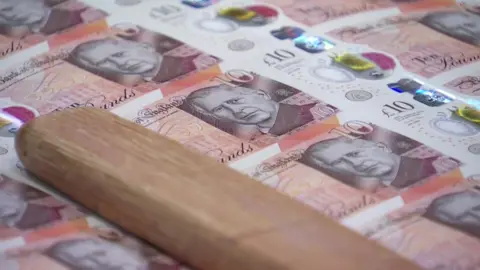King Charles banknotes to enter circulation in June
 BBC
BBCNew banknotes featuring the image of King Charles will enter circulation on 5 June, the Bank of England has announced.
The King's portrait will be the only change to existing designs of £5, £10, £20 and £50 notes, and new notes will replace damaged or worn older ones.
Coins featuring the King are already found in people's change but banknotes required lots of preparation.
Shoppers can and will still be able to use Queen Elizabeth II banknotes.
The reverse side of current polymer Bank of England banknotes, which in ascending order feature Sir Winston Churchill, Jane Austen, JMW Turner and Alan Turing, will be unchanged.
Low-serial numbered notes on new issues are of huge interest to collectors. They will be sold during the summer at auctioneers Spink & Son.
In addition to the auctions, members of the public will be able to enter a ballot to purchase a set of notes. The money raised will be donated to charity.
They will also be able to exchange a limited value of current or old series notes for new King Charles notes, through the Bank of England, for a short time from 5 June.

In April last year, the BBC was given exclusive access to the highly-secure site where notes are being produced for the Bank of England.
However, machines such as self-service tills needed time to recognise the new image which is why it has taken so long for them to enter circulation.
The Queen Elizabeth notes that are already in circulation - some 4.7 billion of them, worth £82bn - can still be used in the shops, even after the new notes enter circulation. The King Charles notes will only replace them when they are no longer fit for use, or when there is any increased demand.
The first Bank of England note to feature Queen Elizabeth II's portrait was a £1 note issued in 1960.
The Royal household has given guidance encouraging such a move, rather than a wholesale switch, in order to minimise the environmental and financial impact of the change.
This month, King Charles's preferred crown is replacing Queen Elizabeth II's favoured symbol on the government's website, marking his role of the head of state.
